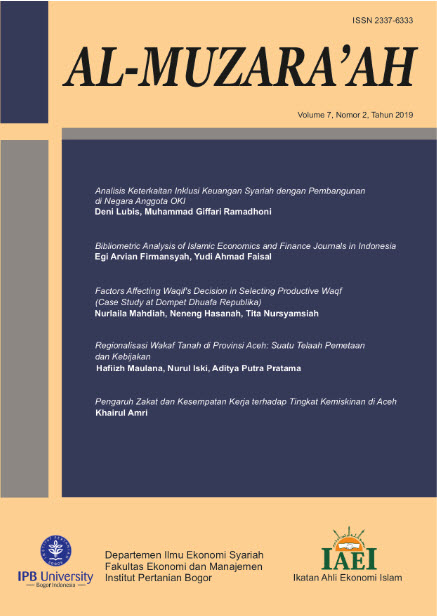Analisis Keterkaitan Inklusi Keuangan Syariah dengan Pembangunan di Negara Anggota OKI
Main Article Content
Abstract
Financial inclusion is one of the main issue on Islamic banking in providing access to financial services to the community. However there are many people who have not access to financial services, especially Islamic banking. This study aims to measure the level of Islamic financial inclusion in several OIC countries (Islamic Cooperation Organization) based on the classification of state income and to analyze the relationship of inclusion of Islamic finance with development. The calculation of the Islamic financial inclusion index used the Index of Syariah Financial Inclusion (ISFI) method. The response variable used in this study is ISFI and the predictor variable is GDP per capita, unemployment rate, number of cellular telephone users, and the population of the village. The method used is descriptive analysis and tobit regression analysis. This study used secondary data from 10 OIC member countries based on the level of state income in 2013-2016. Based on the results of data analysis, high income countries have a high average inclusion rate compared to middle income countries. While GDP per capita and the number of cellular telephone users has a positive effect to the development, meanwhile the unemployment rate has a negative effect.
Downloads
Article Details

This work is licensed under a Creative Commons Attribution-ShareAlike 4.0 International License.
Author(s) who published in this journal agree to following terms:
- Authors understand and agree that copyright of manuscripts published are held by Al-Muzara'ah. The statement to release the copyright to Al-Muzara'ah is stated in form CTA (link doc).
- Copyright encompass exclusive rights to reproduce, to distribute, and to sell any part of the journal articles in all form and media.
This work is licensed under a Creative Commons Attribution-ShareAlike 4.0 International License (CC BY-SA) where Authors and Readers can copy and redistribute the material in any medium or format, as well as remix, transform, and build upon the material for any purpose, but they must give appropriate credit (cite to the article or content), provide a link to the license, and indicate if changes were made. If you remix, transform, or build upon the material, you must distribute your contributions under the same license as the original.
References
Alamsyah, H. (2015). Pentingnya Keuangan Inklusif dalam Meningkatkan Akses Masyarakat dan UMKM terhadap Fasilitas Jasa Keuangan Syariah. Skripsi UIN Sunan Ampel Surabaya.
Ambarkhane, D., Singh, A. S., & Venkataramani, B. (2016). Measuring financial inclusion of Indian states. International Journal of Rural Management, 12(1), 72-100.
Arsyad, L. (2010). Ekonomi Pembangunan. Yogyakarta (ID): UPP STIM YKPN.
Desweni, S. P. (2017). Analisis Investasi dan Pertumbuhan Ekonomi di Indonesia. Menara Ekonomi, 3(5).
Dienillah, A. A., & Anggraeni, L. (2016). Dampak Inklusi Keuangan terhadap Stabilitas Sistem Keuangan Di Asia. Buletin Ekonomi Moneter dan Perbankan, 18(4), 410-430.
Ebrahim, M. S. (2011). Islamic Banking in Sudan. Available at SSRN 1926895.
Grohmann, A., Klühs, T., & Menkhoff, L. (2018). Does financial literacy improve financial inclusion? Cross country evidence. World Development, 111, 84-96.
Hamzah, N. R. (2017). Pengaruh Faktor-faktor Kependudukan terhadap Pembangunan Ekonomi di Kota Makassar (Doctoral dissertation, Universitas Islam Negeri Alauddin Makassar).
[IFSB] Islamic Financial Services Board. (2017). Islamic Financial Services Industry Stability Report 2016. Tersedia pada: http://www.ifsb.org/
Inoue, T., & Hamori, S. (2016). Financial access and economic growth: Evidence from Sub-Saharan Africa. Emerging Markets Finance and Trade, 52(3), 743-753.
Kartono, T., & Nurcholis, H., (2015). Pembangunan Masyarakat Desa dan Kota. Jakarta (ID): Universitas Terbuka.
Kim, D. W., Yu, J. S., & Hassan, M. K. (2018). Financial inclusion and economic growth in OIC countries. Research in International Business and Finance, 43, 1-14.
Kim, J. H. (2016). A study on the effect of financial inclusion on the relationship between income inequality and economic growth. Emerging Markets Finance and Trade, 52(2), 498-512.
Kuncoro, M., (2004). Otonomi dan Pembangunan Daerah. Jakarta (ID): Erlangga.
Demirgüç-Kunt, A., Honohan, P., & Beck, T. (2008). Finance for all?: Policies and Pitfalls in Expanding Access. World bank.
[OJK] Otoritas Jasa Keuangan. (2017). Survei Nasional Literasi dan Inklusi Keuangan 2016 [internet]. [diunduh pada 2019 Februari 21]. Tersedia pada http;//www.ojk.go.id/.
Ozili, P. K., (2018). Impact of digital finance on financial inclusion and stability. Borsa Istanbul Review, 18(4), 329-340.
[SESRIC] Statistical, Economic and Social Research and Training Centre for Islamic Countries. 2016. OIC Countries in Figures (OIC-CIF) [internet]. [diunduh pada 2016 Mei 28]. Tersedia pada: http://www.sescric.org/.
Sarma, M., & Pais, J., (2011). Financial Inclusion and Development. Journal of international development, 23(5), 613-628.
Sarma, M. (2012). Index of Financial Inclusion–A Measure of Financial Sector Inclusiveness. Centre for International Trade and Development, School of International Studies Working Paper Jawaharlal Nehru University. Delhi, India.
Sharma, D. (2016). Nexus between financial inclusion and economic growth: Evidence from the emerging Indian economy. Journal of Financial Economic Policy, 8(1), 13-36.
Umar, A. I., (2017). Index of Syariah Financial Inclusion in Indonesia. Buletin Ekonomi Moneter dan Perbankan. Vol 20 (1), 100-126.
Ummah, B. B., Nuryartono, N., & Anggraeni, L., (2015). Analisis Inklusi Keuangan dan Pemerataan Pendapatan di Indonesia. Jurnal Ekonomi dan Kebijakan Pembangunan, 4 (1).
World Bank. (2017). World Development Indicators (WDI). Tersedia pada: http://data.worldbank.org/
Zins, A., & Weill, L. (2016). The determinants of financial inclusion in Africa. Review of Development Finance, 6(1), 46-57.

